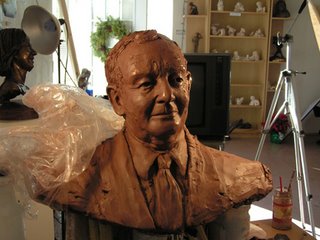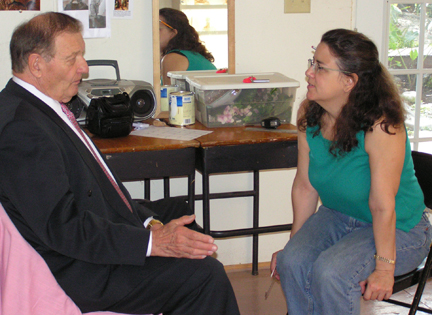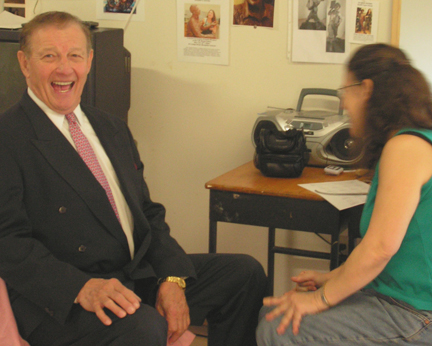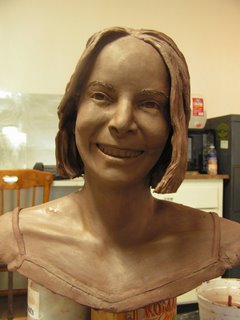Portrait Sculpture
Signing Off On A Sculpture
Just be sure that everything is the way it should be before the sculpture goes into the bronze process. After that, changes can cost a considerable amount of money. In fact, I have my clients sign off on the project at the final sitting, before the sculpture goes to the foundry.
The fear of capturing the expression of someone and investing your time and money into a process with the results being unsure is something to think about. If you have reviewed the artist’s work and credentials and like the artists work, if you have discussed your fears and expectations and provided the artist with the resources that they need, and if you know the artists process includes your input, then your can be assured that the sculpture will be something you like. With all of that said you must remember, it is art, and even my contract states…
“It is here by understood and agreed that it may not be possible to create the Work exactly as described herein or as depicted in preliminary designs, and the Artist shall only be bound to use her best aesthetic judgment to create the Work according to the style and intent of the design, The artist is hereby free to make design modifications as the work progresses.”
I point this out because there was one commission, a posthumous commission where it was impossible to please the client. I have written about this commission in my book “Bringing to Life the Spirit of the Deceased—A Sculptor’s Journey” and at first I was very irritated with the entire process. But my feelings soon changed. You see I was the 3rd or 4th artist that this man came to. He was trying to capture the image of his deceased wife. Though he said I did the best job in capturing a likeness, the commission never came to a finalization. It was after much prayer and consideration that I believe I understood why this happened.
First I think the man was trying to get the artists to create something that just could not be created. In a way I think he wanted his wife back and expected the sculpture to somehow fulfill this need. The second reason was because I have noticed with posthumous sculpture that the emotion, the healing the grieving does not happen when the client comes for the approval and sees this three dimensional loved one, on the contrary it happens when the sculpture is placed, complete and there is nothing left for the client to do but grieve. Until that time the client can busy themselves with the process. The commission gives them something else to do before having nothing else but loss.
Change What?
First let me explain that in a final sitting with the sculptor there is an adjustment period. Moments when you first see the sculpture and you must stop, take time with the sculpture and absorb it. In the case of creating a sculpture in memory of a deceased loved one this can have many other emotions attached to it.
Please be aware that when you do come to a final sitting it is important to be as explicit in your thoughts as possible. Don’t just say it looks strange, say, there looks like there might be too much distance here, or the right eye looks closed and should be opened more. Then let the artist do their work. You see when you work in three dimensional work the artist might have to translate what you say and see if there is something else that is off. If the face looks to narrow, it could be the placement of the ears. If the eyes look too close, it might be the width of the nose. The artist must assimilate your comments and perform their magic.
Photographic Reference
I can’t say enough about photographic reference. I know you will think this is strange but an artist can make a sculpture look exactly like your loved one from one angle, say the front, but when you look at the sculpture from the side it could appear to be someone totally different. That is because the sculptor works in three dimensions. It is imperative that good photographs are provided to the sculptor from both side and front, in fact as many angles as possible, at the photographs should be at the age that you want the subject captured. If it is not possible to provide this then you must understand the limitations that are set upon the sculpture. You might be able to work with the artist one on one to fix any discrepancies in one view or another but this could take an enormous amount of time and patience and should be clarified before the artist give a price.
I believe it was Rodin that talked about how a person cannot look at a true portrait of himself or herself, because often the sculptor captures so much more than the image. It is true that this may play a part in the approval of some sculpture commissions. But more times than not it is something different entirely.
Working Around The Holidays

Working around the holidays. I have been working on this commission, slowly it is coming along. Remember what it looked like just a few weeks ago? I hope to have this bust complete by the end of the week. Another commission has come in and is a rush and must be started next week.
Jeanine and Lucas still have not shipped. I had to find a chain for Jeanine. The chain that is around her neck is real and threads through the heart pendant. Unfortunately it was too long and could not be shortened. So I ran around town for a few days trying to find just the right chain. When I found one it was not the proper metal to be hold a patina. The foundry came to my aid and helped me with providing a chain. Now Jeanine is finished!

meanwhile…
I am struggling with getting just the right materials together to send my book “Bringing to Life the Spirit of the Deceased—A Sculptor’s Journey” off to the publishers.
A New Commission

I am beginning a new sculpture commission today. I move away from death, which I have been working in regularly for the last year and a half and for a change I have a live subject. I even get to see this subject in person, something that is a rarity in my work these days. I always tell people, “The first sitting will take about an hour or so, I take photographs and measurements and try to get to know my subject.” But I am reminded that to capture the essence of someone is deeper than what one can obtain in an hour. I have not thought about it until this very moment, but I do the same process in sculpting the person from life as I do those who are no longer here. I try to find them long after they are gone from my studio. I count on the love of those that know them, and I search for the essence, the special look that the family wants captured and shared with the world. No easy task.

I guess if I could have my way I would stay with a person at least for a weekend. I had that opportunity once with two children. Though even then we are all on our guard. My job is to try and catch a glimpse behind the veils or walls that we unknowingly construct and show to others.
My Dear One -Jeanine

 Jeanine is the third posthumous commission that is write about in the book “Bringing to Life the Spirit of the Deceased—A Sculptor’s Journey” I learned a tremendous amount from this commission and she helped me with my epiphany! Thank you Jeanine
Jeanine is the third posthumous commission that is write about in the book “Bringing to Life the Spirit of the Deceased—A Sculptor’s Journey” I learned a tremendous amount from this commission and she helped me with my epiphany! Thank you Jeanine
Jeanine is also at the foundry and is expected to go home before Christmas. It is a life size bronze bust.
I have also been asked to create a casting of Jeanine’s face from a life mold that her mother had created when she was young. 
